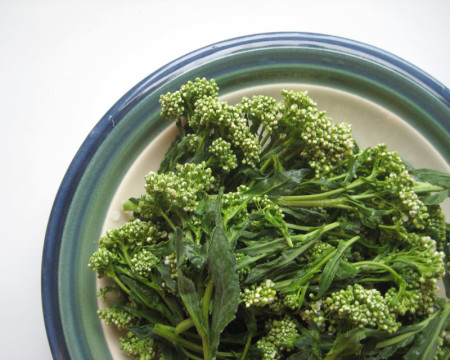
The one nice thing about invasive, edible plant species is that there are more than enough specimens available for kitchen tests, and you don’t feel like you’re dishonoring nature’s gifts when something goes wrong.
Like in my recent countertop honey infused with whitetop flowers (Cardaria spp., Lepidium draba or related Lepidium sp.), which I was hoping would make for a nice, spicy honey mustard condiment. Instead I got icky, pungent, planty goo that Gregg says is smelling up the house.
Fortunately, a few of my other experiments came out pretty good, which is nice considering that I jumped on the whitetop bandwagon a little late this year, collecting one batch in Fort Collins at its prime, pre-flowering, broccoli-like state before the pickings were no longer quite so good. Still, we got a few more meals out of the plant after that, and as the green continues to emerge up here in the high country, there might be another opportunity.
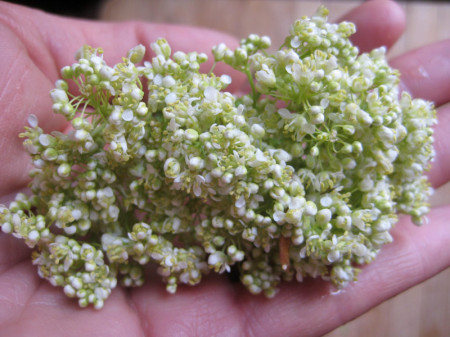
Invasive Mustard
Whitetop is a mustard, native to Eurasia, that was introduced to the US through contaminated seed in the early 1900s, according to the USDA invasive species profile. It has since been reported to occur in most states, with the exception of the Southeast, and across Canada’s southern states. Also known as hoary cress, whiteweed, peppergrass, heart-podded hoarycress, and hoary cardaria, this noxious weed crowds out native species.
According to the Hoary Cress Consortium, a group of scientists exploring the biological control, ecology, and systematics of the plant, “hoary cress currently infests more than a quarter million acres of public and private land and is found on the noxious weed lists of 14 states and one Canadian province.”
The Consortium gives the following identification characteristics: 1) Leaves are entire to shallowly lobed, and the upper leaves … are clasping the stem; 2) If there are hairs on the leaves, they are simple (not stellate or branched); 3) Inflorescence is terminal and wider than it is tall; 4) Fruit must be cordate to round or ovate, and inflated perpendicular to the septum (the septum is the wall that divides the two halves of the fruit). Undeveloped fruit may not inflate very much; 5) Fruit … usually doesn’t pop open to let the seeds out; 6) Two chambers per fruit, and each fruit chamber has 1 or 2 seeds.
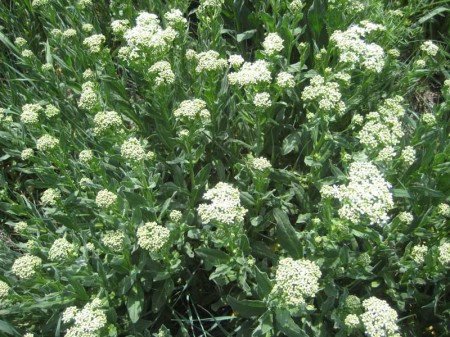
Taxonomy Nightmares
I’ve been back and forth about which species name to use for the invasive whitetop I’ve been eating. In Colorado Flora Eastern Slope: A Field Guide to the Vascular Plants by Weber and Wittmann (4th ed., 2012), which is considered a go-to text among Colorado botanists, the authors include a discussion about whether the plant should be classified as a Cardaria or Lepidium, then use Cardaria, listing several species of the noxious, introduced plant that goes by the common name, whitetop. In his 2012 textbook, Survival Plants, local edible wild plants expert Cattail Bob Seebeck uses Cardaria spp., the “spp” indicating that the described characteristics (including edibility) are similar for all the species in the Cardaria, or whitetop, group.
But under the subheading “Changing Genus,” the Hoary Cress Consortium states that “all species that were considered to be in the genus Cardaria have recently been placed into the genus Lepidium (Al-Shehbaz and Mummenhoff 2002). … Cardaria species have historically been placed in and out of Lepidium, but it appears that they have now found a stable phylogenetic and taxonomic position.”
Except for in Weber and Wittmann, I guess, since the fourth edition of Colorado Flora came out in 2012. And now my head is about to explode with frustration.
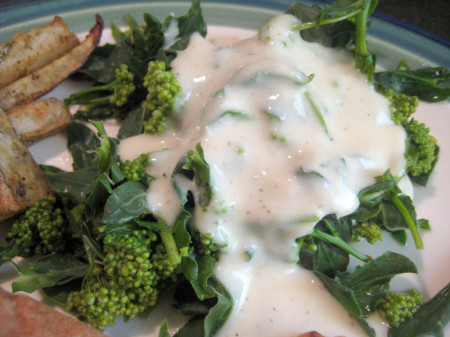
There’s only one thing left to do, I guess—and that is to shut up and gobble down that hoary mustard that defies taxonomic categorization and defiles our innocent native plants.
Whitetop Broccoli with Cheese Sauce
Our first culinary experiment with whitetop flower bud clusters was delicious, though some might argue that it’s hard to make a quiche that isn’t. For the recipe, check out my post, Whitetop—A Wild Invasive Substitute for Broccoli. Also see my friend’s post, Wild Mustard as Broccoli Rabe, which started this whole adventure in the first place.
Upon our first taste test, Gregg and I liked the faux broccoli so much that I collected another batch a week later, only to find the whitetop almost past its pre-flowering prime. I clipped and steamed the smaller flower buds I’d managed to gather along with the stem leaves, and Gregg made a cheesy mustard sauce to serve on top of it.
It was actually just supposed to be a cheese sauce, but while using this recipe, Gregg managed to triple the mustard before asking me to read to him how much the recipe called for. We bolstered the Parmesan to balance the mustard, but it came out mustardy—and delicious—nonetheless. I liked how the prepared mustard complemented the wild, weedy one. The only thing I didn’t enjoy were the lower stem leaves, which I found tough and somewhat difficult to digest.
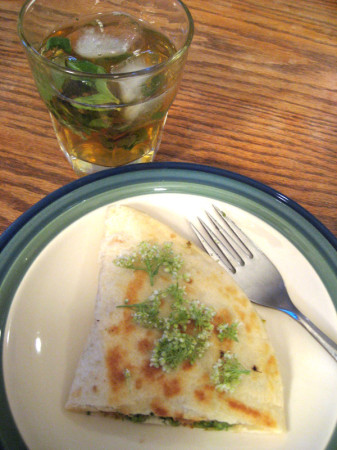
In conclusion, we’ll make this dish again, but I’ll go for only the youngest leaves with my flower bud clusters, or just eat the bud clusters and skip the leaves entirely.
Whitetop Flowers & Chorizo Quesadillas
Still not quite ready to leave whitetop for another spring, I gathered a batch of already flowered tops in the Denver area at my next opportunity. So for this and the next recipe, I used only the flowers. These I washed, in the process discovering a few worms either en route to becoming moths or butterflies, or having already hatched them, leaving behind an empty shell firmly attached to the flower clusters.
“You’re going to wash those well and not give me any with worm skeletons in them, right?” Gregg asked skeptically from behind my shoulder.
“Of course,” I replied as I cut and cleaned a container full of the tiny flowers, tearing the clusters apart into smaller bits to have on hand for when a recipe occurred to me.
Later, the quesadilla idea was born of necessity, as we were hungry and there was very little (normal) food in the house. Good thing I had thawed out a tube of chorizo from the local Scanga meat company earlier that day. This I sautéed in small chunks until it browned and then added the whitetop flowers, stirring for a few minutes until they turned slightly soft and yellow before dumping the whole concoction on a tortilla with a few slices of cheddar to make into quesadillas, garnished with mustard flowers, of course.
The flowers have a somewhat spicy flavor to them. My friend Butter said they remind her of radish. Gregg liked the flavor they added to the quesadillas, which is good, because I’m not in the business of making food that is tasty but obfuscates the flavor of the wild ingredients. At least I don’t think I am.
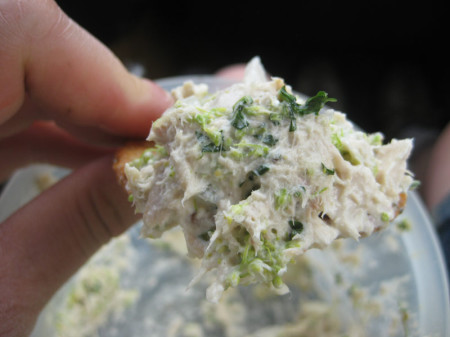
Tuna Salad with Whitetop Flowers & Spring Dandelions
Last but not least, I made a tuna salad with some of the leftover flowers. This should not come as a surprise to anyone who reads my blog, as I often make tuna salad with wild edibles to serve atop crackers when we’re traveling. This one had tuna, mayo, chopped onions, chopped spring dandies, whitetop flowers, salt, and pepper. As with the quesadillas, the whitetop flowers added an interesting new flavor, one that we both found appealing.
Flowers for the Future
The rest of the flower bits I dried for future use, so by all means stay tuned for the exciting results with those sometime in the not-so-distant future.
In the meantime, Butter and I have been discussing how best to dispose of edible invasive parts we don’t eat—especially if they’ve already flowered or gone to seed—so that they don’t propagate in new locations. With the whitetop, I followed her idea to boil the leftover plant parts before discarding. I’ve also seen recommendations to brush off one’s clothes immediately after traveling through stands of invasive species (read: collecting them) so as not to inadvertently spread their scourge to new locations.

NOTE 5.15.14: At least one, albeit somewhat dubious, concern has been expressed about the plant’s edibility. See Whitetop–a Wild Invasive Substitute for Broccoli for that discussion.

These all look amazing! The flavor you describe sounds like it would be the perfect accompaniment to tuna salad, I haven’t tried this plant, but I have had other wild mustards, and I can think of a couple I would like to add to tuna
I love the idea of pairing the spiciness of mustard plants with sausage!
Can’t wait to hear others’ thoughts on disposing of plant material from invasives.
Sadly/happily whitecress has not yet invaded many places in Washington. It sounds delicious.
I’m pretty sanguine about throwing things into my compost – my yard, like much of the city, is already taken over by invasives, so in most cases I’m not bringing home anything new. And while I’ve read a lot of dire warnings about Japanese knotweed’s propensity to sprout from small pieces, I’ve yet to see any growing from the food digester. Honestly, if I somehow displace the English ivy & bindweed & creeping buttercup & stinky Bob in the back patch with more useful invasive species like money plant and lemon balm, I’ll count that as a win.
I’m more worried about making sure that I pack up all the potentially-reproductive plant material I dislodge while harvesting, so that it doesn’t get washed off site. I especially try to avoid disturbing root systems – using a knife/scissors instead of pulling stalks by hand, etc. – since so many things can grow new plants from pieces of rhizome.
The King County noxious weed board recommends putting invasive species in the trash, so that’s what I do with anything I really don’t want to introduce to my invasive species thunderdome – tied up in a bag in the trash.
I’ve tried your whitetop flowers & chorizo quesadillas yesterday and it was surprisingly good. I was wondering what I can use to season my quesadillas and the taste was very unusual yet very nice. I love growing different types of herbs in my garden because they can give my meals a hint of tenderness and spiciness. I love using rosemary in chicken dishes
http://www.foodnetwork.com/recipes/food-network-kitchens/skillet-rosemary-chicken-recipe/index.html
I also love basil in all sorts of meals, especially with tomatoes and cheese. I grow it in my garden and have a huge supply
http://www.askwiki.net/How-to-Grow-Basil
That’s what I made the other day
http://www.bonappetit.com/recipes/2012/07/charred-corn-salad-with-basil-and-tomatoes